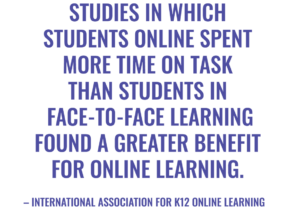By mid-March 2020, nearly every school across the nation closed in order to try to stop the spread of the novel coronavirus and COVID-19 to vulnerable people. Most took a week a or two to take a deep breath, plan, and then took the plunge to embrace online learning. Students of all ages have been learning online now for more than two months, but quite a few parents are looking at their kids’ experiences and scratching their heads about how to make it work better. After all, most of them are not professional educators. Many wish they had a trainer available to give them advice on how to keep their student(s) motivated and get more value from virtual education.

Will Things be “Normal” for Schools in the Fall?
It goes without saying that everyone wants things to be normal for the start of the next school, which feels not very far away. But the plain fact of the matter is that there really can’t be anything close to “normal” until there are effective vaccines and treatments widely available for COVID-19. It’s hard to imagine how schools can safely reopen, though no doubt many will try. Whatever ends up happening with this particular pandemic, there will be another at some point, so now is the time to take in as many tips for effective online learning as possible for whenever it might be needed again.
The distance learning industry has been leveraging the power of the internet to deliver education for years. Companies across the corporate landscape have experience doing virtual training, there are many higher education online degree programs, and even some online high schools have been operating for more than a decade. What’s new, however, is having so many schools for all grade levels make an abrupt shift to virtual learning. Strategies abound for making distance learning work, and in this article we’ll focus especially on tips for parents who have children engaged in virtual learning.
Setting Up a Good Routine is Key
Without the same need to get ready for a normal school day, and with everyone being home all the time (for the most part), it’s all too easy to let what used to be normal routines slip by the wayside. Come up with a routine and stick to it, including a time for going to bed and getting up in the morning, personal hygiene, breakfast and other meals, and so on. The daily routine doesn’t have to be the same as it was during the pre-pandemic school year, but it needs to be regular and you have to stick to it. This is really important for students of all ages.
For the youngest learners, transitions are often difficult, so give them fair warning when a transition is coming up, or use a fun timer device that keeps them aware of upcoming transitions from one activity to another. Build lots of breaks in the day like they would have at school, including snack times and recess or free play. And get them outside whenever possible for fresh air and fun!
The Hardware and Space Logistics of Virtual Learning
Obviously, your student needs a computer to attend each online class they have. A phone, however smart it may be, is not the right tool. The student will need a desktop computer, laptop, or good tablet. If this is an issue for your family, contact your school because the school district is responsible for ensuring students who need equipment get it. But there is also the matter of internet access. Not every household has a reliable internet connection available. Again, if this is an issue for your household, contact your school to see what’s possible. There have been a lot of creative workarounds to these issues, so it’s likely a solution can be found.
Just as important as the equipment, however, is the space where learning will take place. Put a little design effort into creating the right virtual education site in your home. Lying in bed or on the couch with a laptop or tablet is not sustainable or productive. Yes, it should be comfortable for them, but not that comfortable! While engaged in online class, the student should be able to sit comfortably upright in a supportive chair and have their device in front of them on a desk or table. Sure, you can allow the occasional couch session, but it shouldn’t be the norm. Information and practices to make online learning work from home have popped up everywhere on the internet—all you have to do is search for them.
Online Safety is Still a Concern
Kids stuck at home with virtual learning are spending a lot of time on the internet, which puts them at even greater risk than usual for all kinds of online problems, including cyber bullying, harassment, cyber stalking, sexual predation, exposure to pornography, not to mention fraud and identity theft, or getting hacked. As parents, you should have access to all their different online accounts, meaning you have their login credentials and can periodically go in and actively monitor who they’re connected with and what kinds of interactions they are having online. And talk to them about why this is important and how they should always immediately come to you if anything sketchy is happening online.
Maintaining Motivation and Focus in the Midst of Crisis
A lot of students are feeling “down” in the midst of this pandemic crisis. They’re missing being with other kids and their friends physically the way they normally are in school. In other words, many are not feeling very motivated about online learning. And they’re even more susceptible to distractions and losing focus. When things don’t feel normal, it leaves many kids feeling like the attempts to keep learning going are pointless.
Parents can help their students maintain engagement during online learning hours by making a few simple adjustments. If they’re not allowed to have cell phones in class at school, then they shouldn’t have them during learning time at home, either. If putting the phone away isn’t practical, at least make them turn off notifications. You can also use Apple’s “screen time” and Android’s “focus mode” to set accessibility to various apps on a schedule that makes them unavailable during school time. Finally, although it’s a difficult time for everyone, parents need to promote positive attitudes around the house as much as possible, even if you’re not feeling it yourself.
Keeping Interaction Alive with Online Education
It’s up to your children’s teacher(s) to build peer interaction into their online learning. If you feel like there’s not enough of that, contact the teacher and let them know. But aside from online learning with teachers, there are other things parents can do to keep interactions going even during the pandemic. For younger kids, virtual playdate events have become a thing. For these to be effective, a little though needs to go into it. You have to figure out what activities the kids can do together online, such as drawing pictures or doing a craft or something like that, which might also mean coordinating with other parents to make sure they have everything needed.
For older students, have them coordinate online group homework sessions or study-buddy sessions to prepare for quizzes and tests. This can be done with a variety of video chat apps such as Facetime, Google Hangouts, and so on. These interactions outside of class time are going to be very important for older students, and it’s okay if they aren’t the most productive study sessions in the history of education. The peer interaction will be a valuable benefit in and of itself.
Parental Monitoring of Children’s Online Learning
Nothing about all this virtual schooling during a pandemic crisis is normal for anyone. The most important thing parents can do is monitor how children are doing with this new form of education. Observe them. See how engaged they are. Are they taking notes? Are they asking questions? Are they just zoning out? Identify the hang-ups and challenges and then think about what you can do to help them through those. It’s not normal and everyone stressed out, so it’s fine to be flexible and forgiving, but only up to a point. This is not just a “vacation” (and if it is, then it’s the least fun vacation ever), this is what we have for continuing your children’s education, so it needs to be taken seriously.
Achieve Virtual Education Academy: Your Indiana Online High School
We don’t know if traditional education is going be possible for the next school year, but if you’ve found that your Indiana high school student has done well with virtual classes, then consider enrolling them in the online high school program of Achieve Virtual Education Academy. We’ve been doing this for years, which means we know how to do it right. Our program is fully approved by the Indiana Department of Education, all our instructors are real Indiana teachers certified in their subject areas, and it’s completely free for any student who enrolls with a full-time status. Learn more about Achieve Virtual by exploring our website, or feel free to contact us directly with any questions you may have.


